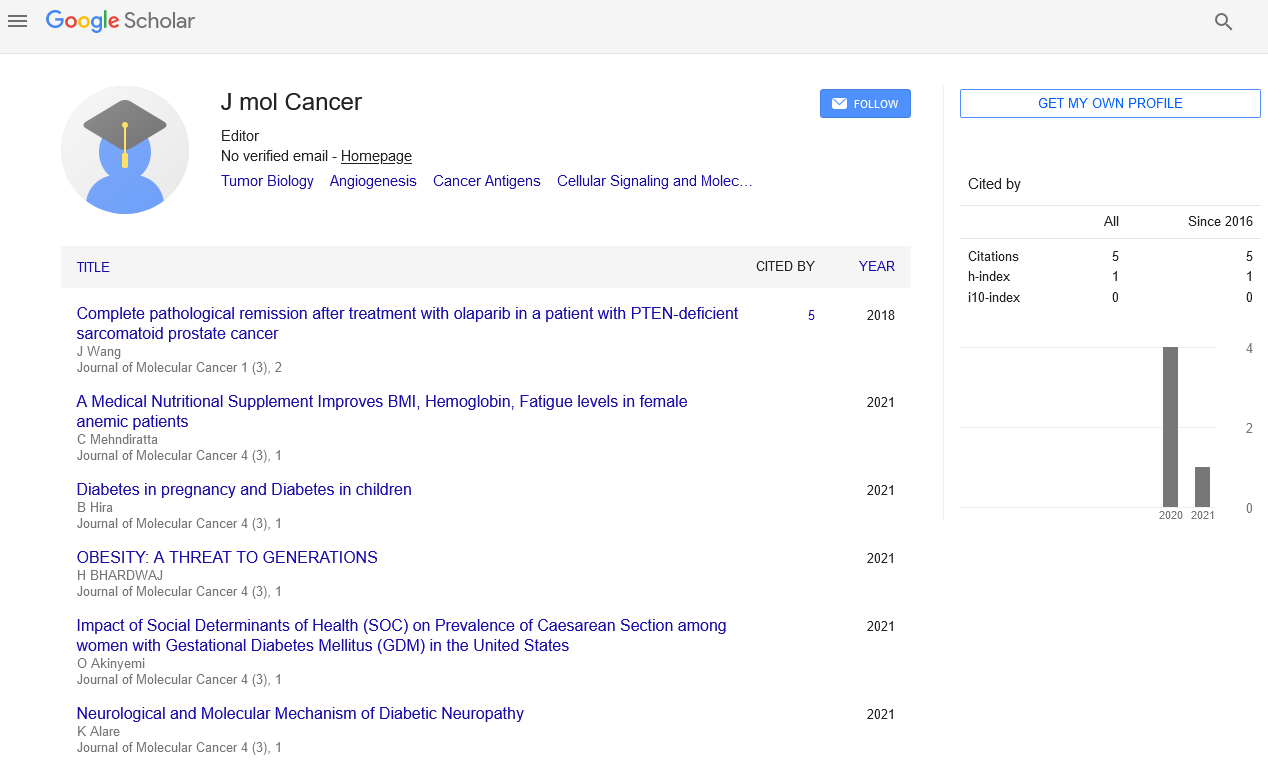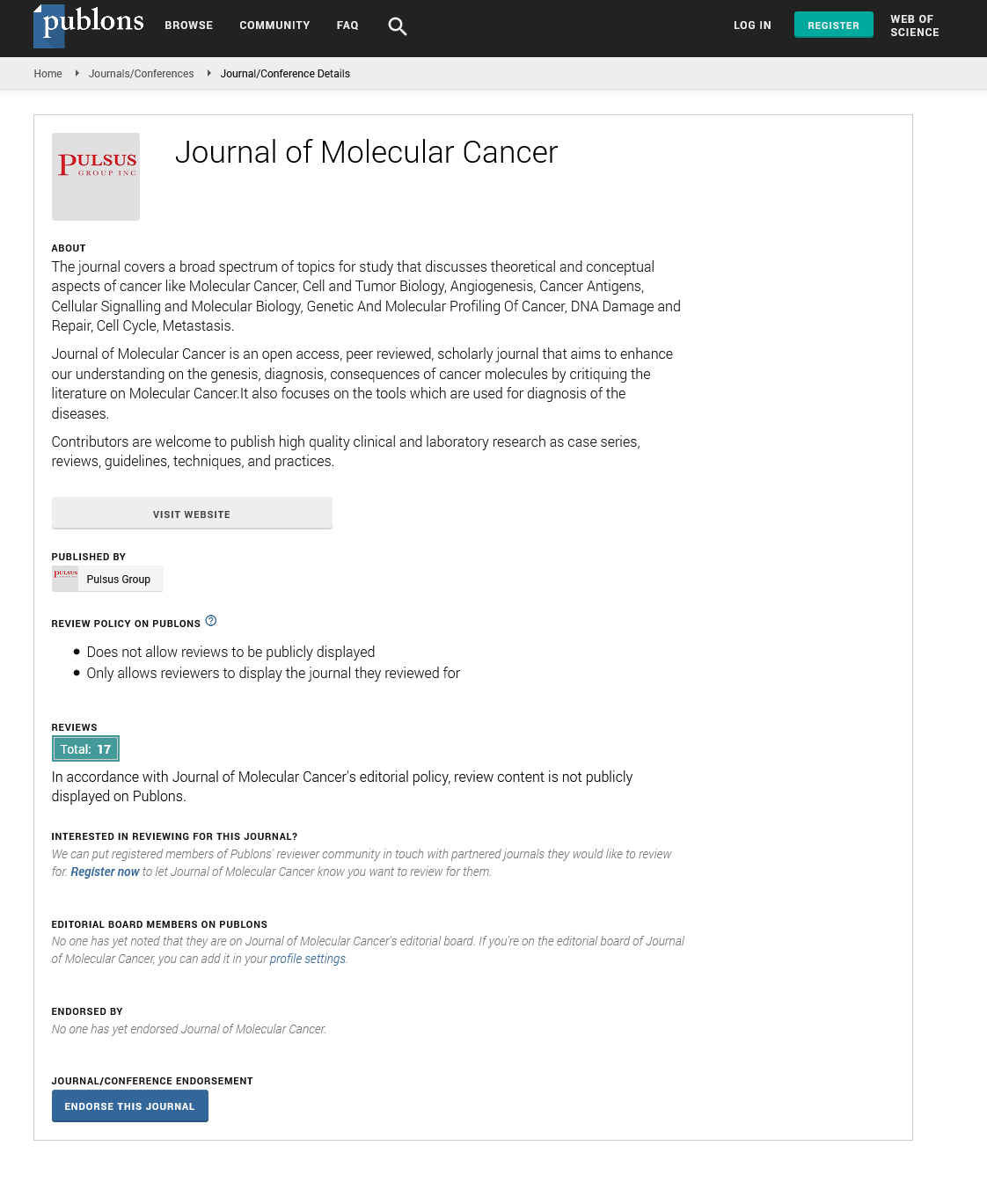Transcriptomics: Unraveling gene expression for advanced genomic insights
Received: 21-Mar-2024, Manuscript No. puljmc-24-7169; Editor assigned: 22-Mar-2024, Pre QC No. puljmc-24-7169; Accepted Date: Apr 26, 2024; Reviewed: 11-Apr-2024 QC No. puljmc-24-7169; Revised: 18-Apr-2024, Manuscript No. puljmc-24-7169; Published: 28-Apr-2024
Citation: Rentsch J. D. Transcriptomics: Unraveling gene expression for advanced genomic insights. J Mol Cancer. 2024; 6(2):1-2.
This open-access article is distributed under the terms of the Creative Commons Attribution Non-Commercial License (CC BY-NC) (http://creativecommons.org/licenses/by-nc/4.0/), which permits reuse, distribution and reproduction of the article, provided that the original work is properly cited and the reuse is restricted to noncommercial purposes. For commercial reuse, contact reprints@pulsus.com
Abstract
Transcriptomics is a dynamic field of genomics focused on the study of RNA transcripts produced by the genome under specific conditions. This discipline offers critical insights into gene expression patterns, regulatory mechanisms, and functional genomics. By analyzing transcriptomes, researchers can gain a deeper understanding of cellular processes, disease mechanisms, and potential therapeutic targets. This article provides an overview of transcriptomics, highlighting its methodologies, applications, and significance in advancing biomedical research. We also discuss the future directions of transcriptomics and its potential impact on personalized medicine and disease management.
Key Words
Transcriptomics; Gene expression; RNA sequencing; Functional genomics; Transcriptome analysis; Personalized medicine; RNA-Seq
Introduction
Transcriptomics is the branch of genomics that focuses on the study of the transcriptome—the complete set of RNA transcripts produced by the genome under specific conditions. Unlike genomics, which examines the static sequence of DNA, transcriptomics provides a snapshot of gene expression and its regulation in response to various stimuli or developmental stages. This dynamic approach is crucial for understanding how genes are expressed, how they interact, and how they contribute to cellular functions and disease states.
The advent of high-throughput technologies, particularly RNA Sequencing (RNA-Seq), has revolutionized transcriptomics by enabling the comprehensive and quantitative analysis of the transcriptome. This has allowed researchers to explore gene expression at an unprecedented resolution, uncover novel transcripts, and identify biomarkers for various diseases. As we advance, transcriptomics is increasingly integrating with other omics fields and computational biology to provide a more holistic view of cellular and molecular processes.
Methodologies in transcriptomics
RNA-Seq is a powerful technology that measures gene expression levels by sequencing RNA molecules. It provides a detailed view of the transcriptome, allowing for the identification of known and novel transcripts, as well as alternative splicing events. RNA-Seq involves isolating RNA from a sample, converting it to complementary DNA (cDNA), and sequencing the cDNA fragments. The resulting sequence data is then analyzed to quantify gene expression and identify differential expression between conditions.
Microarrays were one of the earliest high-throughput techniques for transcriptome analysis. They involve hybridizing labeled RNA or cDNA samples to a pre-defined array of oligonucleotide probes representing known genes. While microarrays are less comprehensive than RNA-Seq, they are still useful for large-scale gene expression studies and have been instrumental in many early discoveries in transcriptomics.
Quantitative PCR is a method used to measure the expression levels of specific genes. While not a high-throughput technique like RNASeq or microarrays, qPCR is valuable for validating findings from other transcriptomic analyses and for quantifying gene expression in targeted studies.
Applications of transcriptomics
Transcriptomics allows for comprehensive gene expression profiling, providing insights into which genes are active, their expression levels, and how these levels change under different conditions. This information is crucial for understanding cellular responses to stimuli, developmental processes, and disease mechanisms.
By comparing transcriptomes from healthy and diseased tissues, researchers can identify differential gene expression patterns associated with various conditions. This can lead to the discovery of biomarkers for disease diagnosis, prognosis, and treatment response. For example, transcriptomic studies have identified biomarkers for cancer, cardiovascular diseases, and neurodegenerative disorders.
Transcriptomics helps elucidate gene function by providing insights into the roles of specific genes in cellular processes. By analyzing gene expression profiles in response to genetic perturbations or environmental changes, researchers can infer the functions of genes and their interactions within cellular networks.
Transcriptomic analysis is instrumental in drug development by identifying potential drug targets and understanding drug mechanisms of action. Additionally, transcriptomics can aid in personalized medicine by tailoring treatments based on an individual’s gene expression profile, leading to more effective and targeted therapies.
Challenges in transcriptomics
Transcriptomic data is inherently complex, with high-dimensional datasets that require sophisticated analytical methods for interpretation. The sheer volume of data generated by RNA-Seq, combined with the need for accurate normalization and statistical analysis, can be challenging.
Integrating transcriptomic data with other omics data (such as proteomics and metabolomics) and clinical information is crucial for a comprehensive understanding of biological processes. However, this integration is complex and requires advanced computational tools and frameworks.
Variability in sample preparation, sequencing technologies, and data processing can introduce technical noise into transcriptomic studies. Ensuring reproducibility and reliability of results is a key challenge in the field.
The emergence of single-cell RNA Sequencing (scRNA-Seq) allows for the analysis of gene expression at the single-cell level. This technology provides insights into cellular heterogeneity, developmental processes, and rare cell populations that are often masked in bulk tissue analyses.
Future transcriptomic research will increasingly integrate with other omics fields, such as genomics, proteomics, and metabolomics. This multi-omics approach will offer a more comprehensive understanding of cellular and molecular processes and their implications for health and disease.
Advancements in computational tools
Ongoing developments in computational tools and bioinformatics are enhancing the analysis and interpretation of transcriptomic data. Improved algorithms for data processing, visualization, and integration will facilitate more accurate and insightful analyses.
Clinical applications
As transcriptomics continues to evolve, its applications in clinical settings will expand. Personalized medicine, drug development, and diagnostic applications will benefit from advances in transcriptomic technologies and their integration with clinical data.
Conclusion
Transcriptomics has transformed our understanding of gene expression and its regulation, providing valuable insights into cellular processes, disease mechanisms, and therapeutic targets. The advent of high-throughput technologies, particularly RNA sequencing, has revolutionized the field by enabling comprehensive and detailed analysis of the transcriptome. Despite challenges related to data complexity, integration, and technical variability, ongoing advancements in transcriptomics hold great promise for advancing biomedical research and personalized medicine.
As transcriptomics continues to evolve, its integration with other omics fields and advancements in computational tools will further enhance our ability to understand and manipulate gene expression. This will lead to more precise and effective approaches to disease diagnosis, treatment, and prevention, ultimately improving patient outcomes and advancing the field of genomics.






